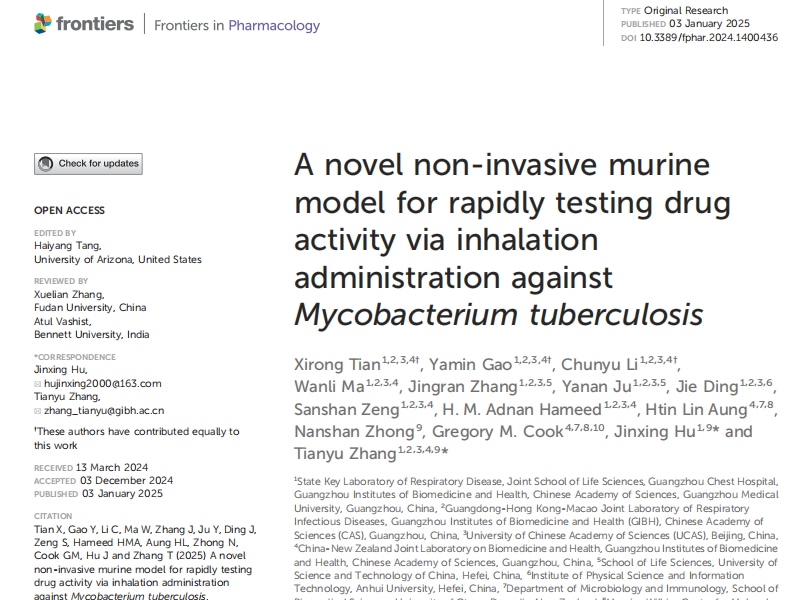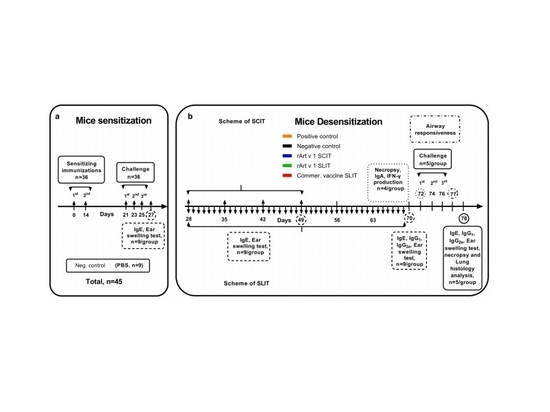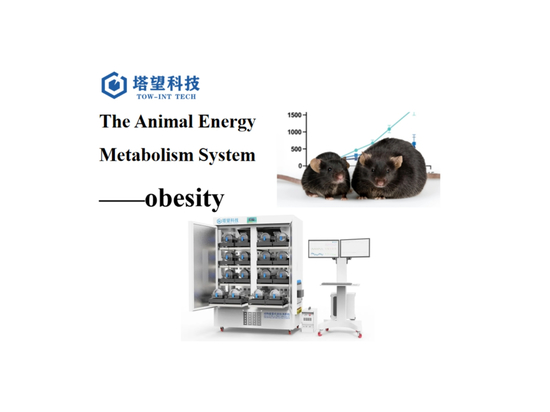
#Industry News
Innovative Breakthrough: Murine Model for Rapid Assessment of Anti-Mycobacterium tuberculosis Drug Activity via Inhalation Administration
A novel non-invasive murine model using autoluminescent M. tuberculosis enables rapid evaluation of inhaled anti-TB drug efficacy via RLU measurement.
Due to suboptimal pharmacokinetic characteristics of conventional oral or injectable routes, the efficacy of most compounds against Mycobacterium tuberculosis (MTB) is often limited by inefficient drug distribution and metabolism. To enhance localized drug concentrations in the lungs, inhalation-based delivery has emerged as a research priority, enabling targeted delivery to directly elevate drug exposure at infection sites. However, existing models predominantly rely on wild-type MTB strains, which suffer from operational complexity, prolonged experimental timelines, high labor costs, and poor reproducibility.
In this study, Tian X, Gao Y, Ma W, and colleagues developed an inhalation-based evaluation model utilizing autoluminescent Mycobacterium tuberculosis (AIRv). This model dynamically monitors drug activity by quantifying relative light units (RLUs) emitted from live mice infected with the autoluminescent strain. The innovative approach offers the following advantages:
1. Streamlined Procedures: Eliminates the need for mouse anesthesia, simplifying drug administration and instrument operation.
2. Cost Efficiency: Replaces large animal models with mice, significantly reducing experimental costs.
3. Accelerated Timeline: Compresses the traditional evaluation period from months to 16–17 days.
4. Non-Invasive Assessment: Uses live RLUs as a surrogate for colony-forming units (CFUs), avoiding animal sacrifice.
5. High-Throughput Capacity: Enables simultaneous daily administration to six mice, with potential for 2–3 doses per day.
6. Enhanced Reliability: Objective RLU measurements minimize human intervention and improve reproducibility.
Proof-of-concept experiments demonstrated that inhaled rifampicin, isoniazid, and ethambutol exhibited potent anti-tuberculosis activity at low concentrations (0.5, 0.5, and 0.625 mg/mL, respectively), with RLU results strongly correlating with therapeutic efficacy. Further validation confirmed a consistent ratio (~10:1) between lung RLUs and CFUs, reinforcing RLUs as a reliable efficacy indicator. This method establishes an efficient and precise platform for rapid evaluation of inhaled drug activity in vivo.
Experimental Methods
1. Strain and Culture:
The autoluminescent Mycobacterium tuberculosis strain (AIRv), carrying the luxCDABE gene cluster, was cultured in Middlebrook 7H9 broth until reaching the logarithmic growth phase (OD600 = 0.6–0.8; RLUs ≈ 5 × 10⁹/mL).
2. Animal Model Establishment
2.1 Infection: Female BALB/c mice were infected with AIRv via an aerosol inhalation system and randomly divided into groups (6 mice per group).
2.2 Initial Bacterial Burden: On day 3 (Experiment 1) or day 1 (Experiment 2) post-infection, mice were anesthetized for chest RLU detection. A subset of mice was euthanized, and lung homogenates were analyzed for RLUs and CFUs (via 7H10 agar plates with a 4-week incubation) to assess baseline infection levels.
3. Inhalation Drug Administration
Drugs (rifampicin [RIF], isoniazid [INH], and ethambutol [EMB]) dissolved in sterilized water (dose range: 0.125–10 mg/mL) were nebulized and administered daily using a nose-only exposure device (Tow Systems Nose-Only). Each treatment session lasted 20–25 minutes, continuing for 14–15 days.
4. Efficacy Evaluation
4.1 Live RLUs: RLUs were non-invasively measured from the chest region of live mice using a luminometer (GLOMAX 20/20) for dynamic drug efficacy monitoring.
4.2 Terminal Analysis: Post-experiment, mice were euthanized. Lung homogenate RLUs and CFUs were quantified to validate their correlation (approximate ratio: 10:1).
5. Pharmacokinetic Studies
5.1 Sampling: Plasma and lung tissues were collected at specified time points post-inhalation. Drug concentrations were determined via liquid chromatography-mass spectrometry (LC-MS).
5.2 Parameter Calculation: Pharmacokinetic parameters, including the area under the curve (AUC) and half-life (t₁/₂), were analyzed to evaluate drug retention and efficacy in lung tissues.
Experimental Results
1. Validation of Murine Model Efficacy
Strong Correlation Between RLUs and CFUs: The relative light units (RLUs) of autoluminescent Mycobacterium tuberculosis (AIRv) in the lungs exhibited a consistent ratio of approximately 10:1 to colony-forming units (CFUs)(p<0.0001), confirming RLUs as a reliable surrogate marker for rapid drug efficacy evaluation.
2. Drug Activity Assessment
2.1 Single-Dose Experiment:Rifampicin (RIF 2 mg/mL), isoniazid (INH 2 mg/mL), and ethambutol (EMB 10 mg/mL) significantly reduced both lung RLUs and CFUs compared to the solvent control (p<0.0001).INH at the high dose (2 mg/mL) nearly eradicated bacteria, with CFUs approaching zero.
2.2 Dose-Dependent Activity: Rifampicin: Only the highest dose (2 mg/mL) showed significant bacterial inhibition (p<0.0001), while lower doses (0.5 and 0.125 mg/mL) were ineffective. Isoniazid: Both 2 mg/mL and 0.5 mg/mL significantly reduced bacterial burden (p<0.0001), whereas 0.125 mg/mL had no effect.Ethambutol: Doses of 10 mg/mL and 2.5 mg/mL markedly decreased RLUs and CFUs (p<0.0001), while the lowest dose (0.625 mg/mL) showed weaker efficacy (p<0.05).
3. Pharmacokinetic Properties
3.1 Rapid Absorption: Rifampicin (2 mg/mL): Peak plasma concentration (16.65 ± 3.91 μg/mL) and lung tissue concentration (2.33 ± 0.89 μg/g) were achieved within 5 minutes post-inhalation. Isoniazid (0.5 mg/mL): Lung concentrations dropped to near-undetectable levels within 30 minutes, necessitating multiple daily doses. Ethambutol (10 mg/mL): Peak lung concentration reached 10.94 ± 1.63 μg/g, maintaining effective levels (>10 hours).
3.2 Prolonged Retention:Rifampicin and ethambutol sustained effective concentrations in lung tissue for 24 hours and 10 hours, respectively, significantly exceeding their in vitro minimum inhibitory concentrations (MICs).
Conclusion
By integrating autoluminescent bacterial strains with inhalation administration technology, this model enables rapid and precise evaluation of anti-tuberculosis drug activity. It significantly enhances drug development efficiency and provides critical technical support for the development of novel therapeutic regimens.
Tow-Int Tech Nose-Only Inhalation Exposure System
In this study, Tow-Int Tech’s proprietary Nose-Only Inhalation Exposure System was utilized to administer inhaled therapies (e.g., rifampicin) to mice. The results demonstrated that this inhalation-based approach significantly enhanced therapeutic efficacy compared to traditional oral or injectable routes, improving drug development efficiency.
The nose/mouth inhalation exposure system is designed for precise oral/nasal drug delivery and inhalation exposure experiments in laboratory animals such as mice, rats, and guinea pigs. Featuring an airtight design and uniform exposure concentration, the system is ideal for inhalation studies using liquid aerosols, dust aerosols, nanoparticle aerosols, smoke, and other inhalable agents. It ensures consistent dosing across animals within the same experimental group, enables real-time aerosol concentration monitoring and sample collection, and incorporates a high-precision control system to maintain exposure homogeneity and stability.
Additionally, the system supports testing of diverse substances, including pharmaceuticals, atmospheric pollutants (e.g., PM2.5), organic compounds, industrial chemicals, and agricultural agents. It accommodates various experimental protocols such as acute/chronic exposure, low/high-pressure conditions, and hypoxic/hyperoxic environments, offering flexibility for advanced toxicological and pharmacological research.
References:
[1]Tian X, Gao Y, Ma W, et al. Establishment of an Inhalation Administration Non-invasive Murine Model for Rapidly Testing Drug Activity against Mycobacterium tuberculosis[J]. bioRxiv, 2024: 2024.02. 27.582260.
Contact us now!
We are committed to making your research easier, more accurate, and more efficient and helping you build confidence in your data! We have provided services for a large number of customers and have rich experiences in offering customized, professional solutions according to your needs.





